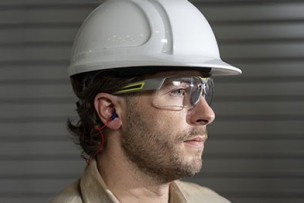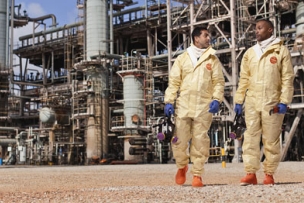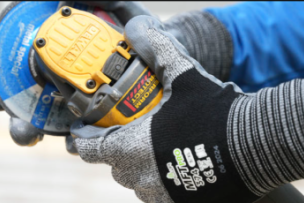The third layer, PPE, may be the last line of defense against heat stress, but it’s one that has benefited from strides in technology. These include cooling vests and performance apparel such as neck gaiters.
Why Cooling PPE Is Crucial in Hot Work Environments
The body usually gets rid of excess heat through increasing blood flow to the skin and through sweating. Hot work environments, however, are too humid or have too little airflow for these bodily functions to be effective.
In hot environments, cooling PPE is an effective tool to bring down body temperature and keep workers safe and comfortable.
“Workers wearing cooling PPE experience a decrease in heat-related illness of up to 50 percent,” says Lexi Engelbart, Ergodyne’s product manager of heat stress categories, including cooling and skin protection.
Read more: Heat Stress Prevention: Safety in Manufacturing and Industrial Environments
Keeping workers cool with PPE also helps with productivity. Case in point: Supporting the federal government during an Ebola outbreak, OccuNomix outfitted medical teams with cooling PPE in hot conditions and noticed a positive impact.
“The doctors were wearing a full Tyvek suit, and it got extremely warm. They were able to double the output time that they spent with their patients because they had a cooling vest on,” says Jeff Belin, who leads business development for OccuNomix.
“Think about that in any type of environment,” he says. “If you’re a foundry worker, you’re able to maintain comfort and remain in your work environment for longer.”
Different Types of Cooling PPE
As with most PPE, many options are available to suit an employee’s need given the unique conditions of the workplace and the task. Cooling PPE includes cooling vests and evaporative cooling garments and accessories in all shapes and sizes.
Cooling Vests: Sustained Relief with Phase Change Materials
Manufacturers of cooling PPE products agree that one type of cooling technology—phase change—is best for indoor environments because it doesn’t rely on airflow to work. Phase change packs are designed to maintain a consistent coolness regardless of the ambient temperature.
Ergodyne’s phase change cooling vests, for example, are formulated to stay at 64 degrees F while they’re activated. “That technology absorbs the latent heat from our body, and it’s going to provide a prolonged cooling sensation,” Engelbart says. “Depending on the phase change item that a worker chooses, you can get between an hour and up to four hours of cooling.”
Phase change products can be reactivated by placing them in a cold container, whether it’s a freezer or a cooler of ice or ice water. Workers can wear one pack while another one is being reactivated and then change them out as needed.
“We ship our packs in an insulated cooler bag. A lot of people put ice in that with an extra set of packs, and then they can keep swapping those out all day,” Belin says. “It’s nice that you don’t have to have electricity or access to a freezer. Of course, if you have a freezer, it’s going to recharge quicker.”
OccuNomix’s phase change products maintain 58 degrees F while activated.
“It’s a temperature where it could cool the core but not be too cold where you have to take it away from your skin too quickly,” Belin says. “It also doesn’t cause a vasoconstriction response—so, it allows for proper blood flow but still maintains that cool temperature.”
Besides cooling vests, phase change technology is available in neck gaiters, neck wraps and hard hat inserts.
Evaporative Cooling: Best for Low-Humidity Settings
In worksites with good airflow and low humidity, evaporative cooling PPE performs well and helps prevent heat stress.
Evaporative cooling works by soaking a product in water and letting the moisture evaporate, drawing heat away from the body.
A cooling towel made of performance fabric such as microfiber, for example, could be dunked in ice water, wrung out and worn around the neck. “The airflow over the garment or accessory evaporates the water that’s stored in it, and that creates a cooling effect,” Belin says.
From MSC: Explore Summer Essentials to Stay Cooler, Safer and More Productive
Performance fabrics also can be activated by sweat. “As that moisture evaporates off the skin, it takes some of our body heat with it,” Engelbart says. “If we can pick a fabric that grabs onto that moisture and quickly moves it off the skin, that’s going to more effectively cool a worker down quicker.”
Whereas phase change maintains a consistent temperature, evaporative cooling is relative to the environment. “With our MiraCool HyperKewl, which is our top-of-the-line evaporative fabric,” Belin says, “you could expect about a 10-degree Fahrenheit difference from the ambient temperature with proper airflow.”
How to Select the Right Cooling PPE for Your Team
With so many products to choose from, what is the best cooling PPE? Well, it depends.
“The world of cooling PPE is quite vast,” Engelbart says. “You need to understand your job scope and what’s going to work for you and your team.”
Engelbart recommends picking primarily based on environmental conditions—namely, airflow and humidity—as they make certain cooling PPE more effective than others. In a humid manufacturing building, for instance, water-activated fabrics won’t evaporate well, leaving workers overheated and uncomfortable.
“Sometimes we’ll hear that the cooling didn’t feel that intense or didn’t last very long,” she says. “And usually, the root of the problem is that people are using technology that is better suited for other environments.”
Also, consider uniform requirements, such as additional PPE that might restrict evaporation or airflow.
After weighing those main factors, “then home in on preference,” Engelbart adds. “Is it a headband? Is it a gaiter? Is it a vest? There are a lot of great options at great price points. You don’t have to invest a ton of money into this.”
What tips do you have for using cooling PPE products at work? Let us know in the comments.





Talk to Us!
Leave a reply
Your email address will not be published. Required fields are marked *